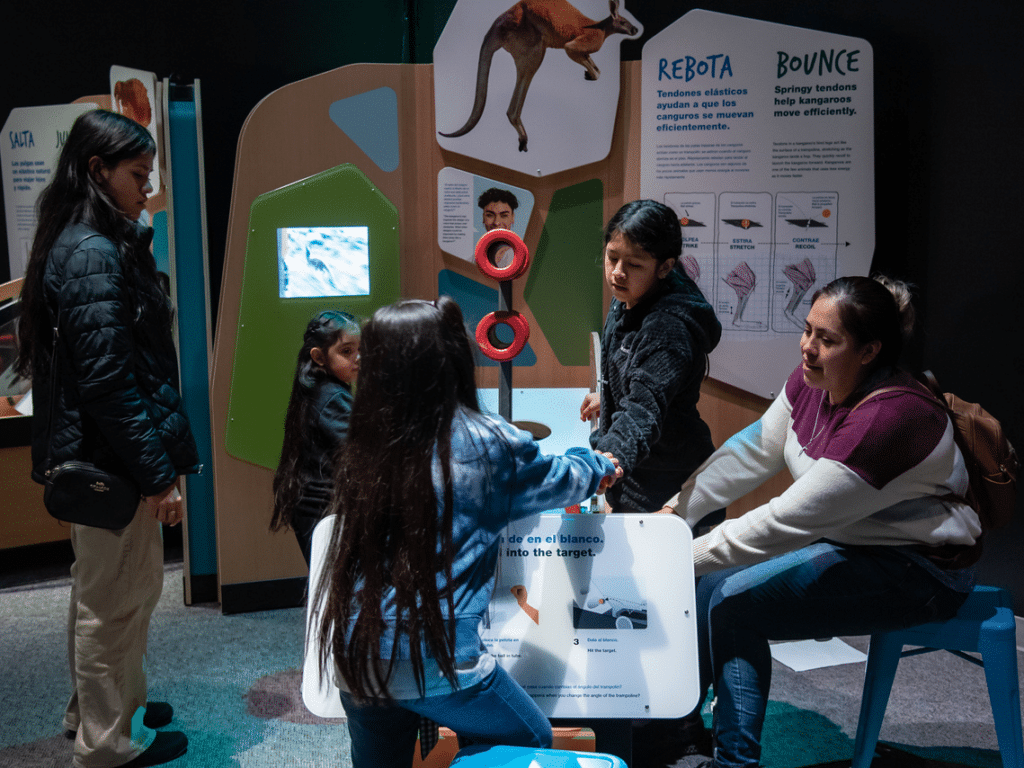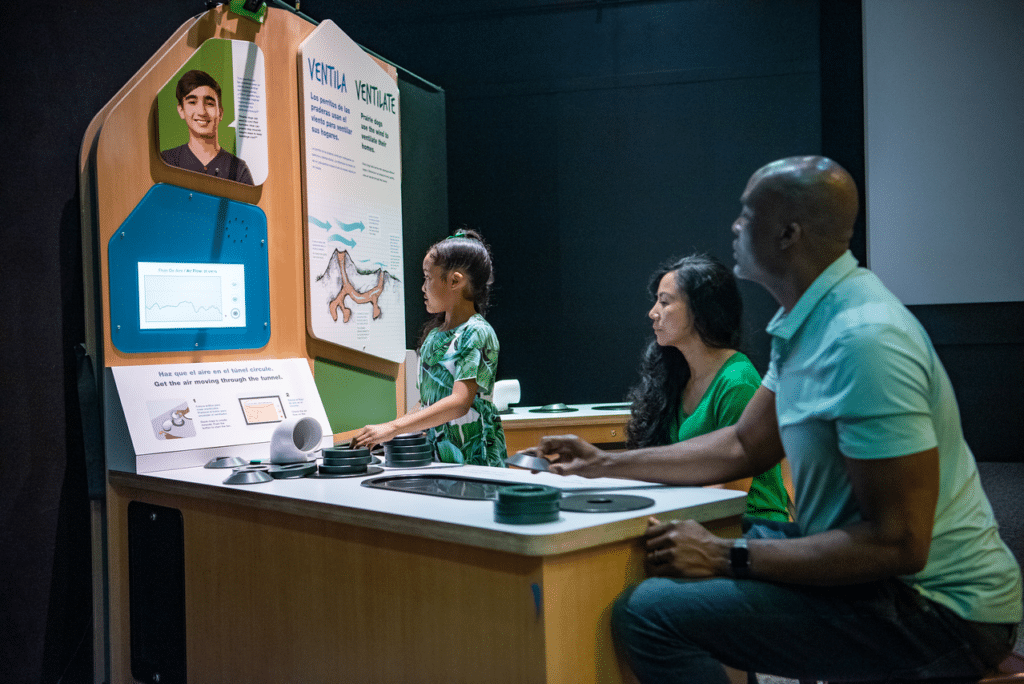Project Description
Designing Our Tomorrow: Mobilizing the Next Generation of Engineers was a 6-year, National Science Foundation-funded, Innovations in Development project, carried out between 2018-2024 by the Oregon Museum of Science and Industry (OMSI) and its partners: Adelante Mujeres, the Biomimicry Institute, and the Fleet Science Center.
Guided by research and evaluation, the project included the development of resources for educators and exhibit developers, as well as the biomimicry focused Creatividad silvestre | Wild Creativity exhibit. Biomimicry was highlighted because it engages us with nature’s strategies to design solutions for the challenges we face in our own communities around the world.
Focusing on girls ages 9-14 and their families, this project was co-developed with culturally responsive strategies to ensure the inclusion and influence of Latino communities.
Mobilizing the Next Generation of Engineers
2018-2024
Resources & Research
Engineering Practices Research
This project included two studies (C-PIECE Study and the EP&UDL Study) that build on prior work using bilingual exhibits to teach engineering proficiencies and research on engaging girls in STEM.
C-PIECE Study
The C-PIECE Study, A study of collaborative practices at interactive engineering challenge exhibits, was the first of two research studies in the the DOT research program.
The purpose of the C-PIECE Study was to develop theory-based measures of engineering proficiencies within an exhibit context.
The C-PIECE Study developed ways to measure engineering proficiencies, intergenerational collaboration and visitor satisfaction. This includes the theory-based C-PIECE framework which provides informal education professionals with a guide when co-developing, designing, facilitating, evaluating and researching engineering design challenge experiences. This framework was used during the development of the Creatividad silvestre | Wild Creativity Exhibit.
C-PIECE Framework

EP&UDL Study
A study of conversation participants’ choices and connections on the topic of engineering practices and usefulness in day-to-day life (EP&UDL Study) looked at the storytelling choices parents and educators use to communicate to other parents and educators that the practices used at the Creatividad silvestre | Wild Creativity Exhibit in the exhibit are usefully relevant to engineering practices in families’ everyday lives and their community goals.
To center the voices of parents and guardians (caregivers), parents participated in the project as storytellers and researchers. They created and revised stories building on theories of relevance in education and the C-PIECE framework.
The study was designed to support stories that are part of ecological communications. The approaches and model emerging from this evidence can inform many types of stories that are told about the value and usefulness of exhibits, such as between parents or between educators and parents.
Creatividad silvestre | Wild Creativity Exhibit
The Designing Our Tomorrow project produced Creatividad silvestre | Wild Creativity Exhibit, a bilingual Spanish/English 2,500 square foot traveling exhibition on tour until 2030. The exhibits engage visitors in biomimicry, an approach to engineering where we can learn from nature’s strategies to design solutions for the challenges we face in our own communities and around the world.
Developed in partnership with Adelante Mujeres, Biomimicry Institute, and the Fleet Science Center, the exhibit is the first of its kind and this exhibit serves a model for others. The creation of the exhibit was guided by a theory of action, and utilized the C-PIECE framework to help provide a theoretical and research based foundation.


The exhibit’s theory of action and engagement guided the development of the exhibit and was informed by valuable insights and perspectives of a Youth Advisory Board comprised primarily of Latina girls aged 9–14.
Examples of exhibits in action

Salta | Jump
A family adjusts the angle and spring tension of a ball launcher, learning about how fleas store and release energy .

Rebota | Bounce
By adjusting the angle of trampolines and drop height of a ball, a family learns about how kangaroos bounce to gain energy

Vuela | Fly
Mimicking natural strategies from squirrels, dandelion seeds, and gliding birds, two youth create kite designs to test how much wind energy their designs can produce.

Ventila | Ventilate
A family stacks prairie dog tunnel “mounds” of different shapes and heights at the entrances to change airflow within the tunnel.
Find out more about Creatividad silvestre | Wild Creativity
Design Challenge Resource Collection
The Design Challenge Resource Collection contains examples, tools and approaches the OMSI team has found valuable when developing accessible, relevant and engaging exhibits that provide non-facilitated engineering design challenges.
These examples are split into stand alone modules and are designed for someone to read individually or facilitate with a team.
Introduction to Design Challenges ↓
Explore the history, benefits and key characteristics of engineering design challenge exhibits.
Exploring Design Challenges ↓
Use this tool to take a close look at some existing exhibits and identify factors you want in your exhibit.
Approaches to Exhibit Accessibility ↓
Make exhibits that work for everyone; a framework for thinking about accessibility of exhibits.
Testing a Design: Measures of Success ↓
See examples of ways visitors can receive feedback about the success of their designs.
Exhibit Design Sprints ↓
Learn about processes to quickly generate, evaluate, iterate and improve ideas for an exhibit.
Graphic Development for Design Challenges ↓
Dive into types of graphics, placement and best practices for exhibit labels.
Prototyping Design Challenge Exhibits ↓
See tips and tricks for testing your ideas to save time, money and create a great experience.
Participatory Co-development of a Bilingual Exhibit ↓
Ensure the context of your exhibit will be relevant and interesting to audiences.
Documenting Exhibits – The Exhibit Record Tool ↓
Find out about exhibit records that concisely document and communicate the purpose and vision of your exhibit.
Educator Resources
We all engineer. This wide range of activities and professional development resources use approaches to interest and engage women and girls in engineering.
Professional Development
Activities to Use with Youth
The activities in this section were developed through a previous NSF funded project, Designing Our World (DLR-1322306). While these activities are not related to biomimicry, they are included because they engage youth in the engineering design process and were useful in guiding the development of this project.
DOW Introductory Materials ↓
This manual was written to guide program facilitators through behavioral, structural, and curricular aspects of the Designing Our World (DOW) programs.
Who is an Engineer? ↓
This discussion-based activity activates prior knowledge of engineering and challenges stereotypes about who can be an engineer.
Energetic Ocean ↓
Participants design a model offshore wind and wave energy farm to maximize the amount of energy the farm can produce.
Get It Together ↓
Participants plan an efficient assembly line process to put together emergency supply kits.
Pollution Solution ↓
Participants create model neighborhoods that incorporate green spaces, such as bioswales and parks, to prevent pollution from flowing into a river.
Save the Day ↓
Participants play a card game to generate ideas for creative designs that will help different people and animals in various disaster scenarios.
Shake, Don’t Break ↓
Participants determine the effectiveness of various materials at isolating the base of a structure during a simulated earthquake.
Smooth Travels ↓
Participants design an accessible path that will allow for the slowest, safest route possible down a mountain.
Sounds of the Sea ↓
Participants engineer carriers to hold different objects underwater at particular depths.
Surgical Solutions ↓
Participants develop, build, and test a surgical tool to use in various model medical challenges.
The Perfect Present ↓
Participants design and improve a gift for their class partner based on their individual needs and unique interests.
Zip Line Rescue ↓
Participants design and build a zip line carrier that will move an injured or stranded person safely and quickly out of danger.
Creatividad silvestre | Wild Creativity Educator Guide
This guide contains material to help educators facilitate experiences at the Creatividad silvestre | Wild Creativity exhibit. Although created specifically for use with Creatividad silvestre | Wild Creativity, the activities and information may be adapted for use in other situations.
Publications and Presentations
Research Papers
Evaluation Reports
Throughout the project, evaluation activities were used to help monitor team engagement in continuous improvement, provide accountability, build knowledge, and inform project deliverables. Much of the evaluation was conducted by OMSI evaluation staff, with the summative evaluation conducted by Rockman et al.
Presentations
Collaborators




This material is based upon work supported by the National Science Foundation under Grant No. DRL-1811617. Any opinions, findings, and conclusions or recommendations expressed in this material are those of the authors and do not necessarily reflect the views of the National Science Foundation.